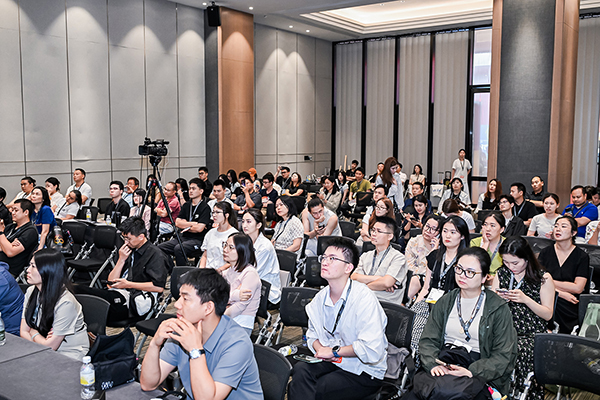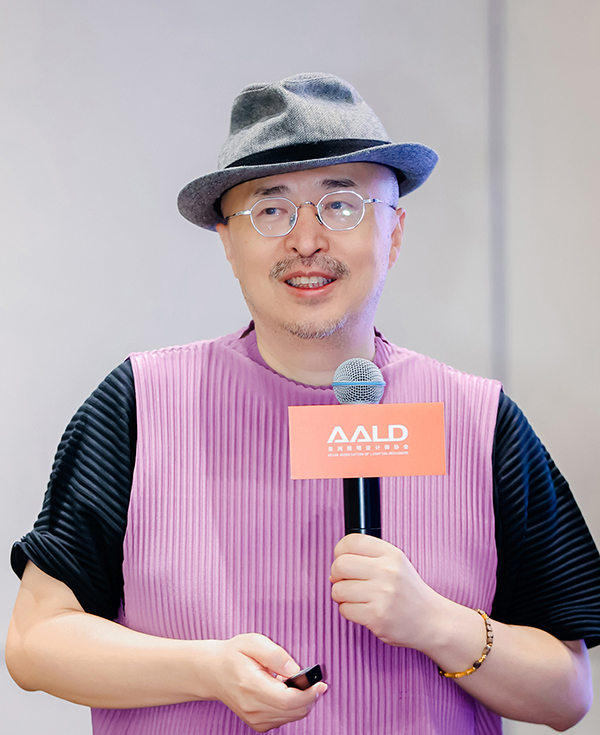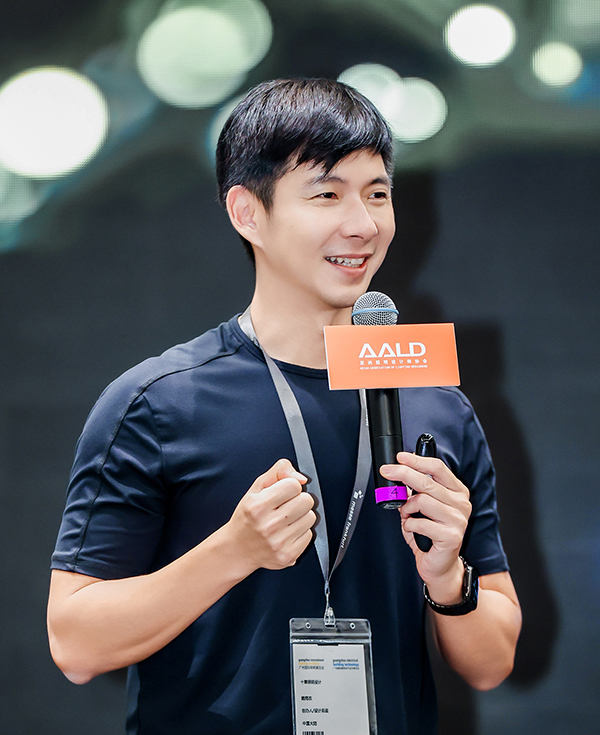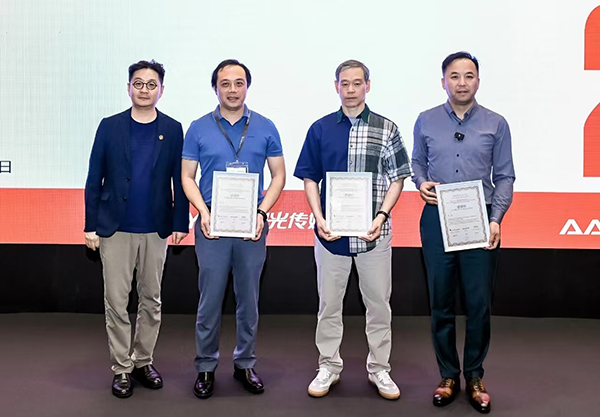- News Center
Event news
AALD News
Asia Lighting Arts Symposium
The 21st Asia Lighting Arts Symposium came to a successful conclusion, exploring the new future of "360°+ AI" together

The 21st Asia Lighting Arts Symposium was successfully held on June 9th and 10th. This forum is jointly organized by Guangzhou Guangya Frankfurt Lighting Exhibition Company and the Asian Association of Lighting Designers (AALD), and hosted by Yangguang Media. It is one of the concurrent events of the Guangzhou International Lighting Exhibition. The forum adheres to the theme of "360º+AI", promoting innovative applications in the lighting industry through the all-round integration of AIGC technology, accelerating the intelligent transformation of light scenes, and injecting new impetus into the development of the industry.
Light + Cross-border Special Event

Mr.Chen Lijian
Mr. Chen Lijian, the executive director of AALD and the chairman of Junwei Tongchuang Cultural Tourism Industry Investment Co., LTD., in his keynote speech titled "Light in the Eyes of Interior Designers: AI Empowering Design Innovation", demonstrated how AI can generate lighting solutions that meet requirements based on instructions, including precise control of parameters such as color temperature, illuminance, and lumens. He emphasized that AI can not only complete basic design work, but also provide decision-making assistance through data analysis, helping designers optimize design plans and enhance customer satisfaction. He believes that the design model combining humans and machines will become mainstream, and there will be more and more opportunities for cross-disciplinary cooperation.

Mr.Yu Ting
With the theme "MORE is LESS: Architecture is Affects", Mr. Yu Ting, founder and principal architect of Wutopia Lab, delved into the idea of architecture as a medium of emotion. He emphasized that architecture is not only a functional space but also a container for emotions and memories. Through multiple project cases, he demonstrated how to evoke people's emotional resonance through design. For instance, in the design of Shanghai Book City, he combined perforated aluminum plates with LED lights to create a visual effect of thousands of lights, which not only reflected the city's memory but also endowed the building with new vitality.He also emphasized the significance of light in architecture, believing that light is not only a tool for illumination but also a medium for creating atmosphere and emotions. In the design of the Monologue Art Museum, he ingeniously utilized natural light and sunlight to create a serene and poetic space, allowing people to find the joy of solitude within it.
Light + Architecture Special Session

Mr.Lai Yunong
Mr. Lai Yunong, Executive Director of AALD, Coordinator of IALD Greater China, founder/Design Director of Yu Lighting Design, emphasized in his keynote speech "Follow the Light" that lighting design is not just about illuminating Spaces, but about creating experiences that immerse people and leave a lasting impression. He demonstrated this concept through multiple project cases, such as the lighting renovation plan of the Bund in Shanghai. By adopting a color-changing and programmable dynamic approach, the "Golden Bund" was preserved while increasing the variability of the lighting.In the riverbank lighting renovation project in Kaohsiung, Taiwan, 120,000 control points were used to achieve interactive and immersive lighting experiences, generating significant economic benefits. Finally, he took the New Year's Eve light show at Taipei 101 as an example to demonstrate the integration of five specialties: video, music, fireworks, lighting and laser, creating a stunning visual effect.He concluded that no matter how technology advances, the core of design remains light. Only by grasping the essence of light can one truly touch people's hearts.
Ms. Hu Wenye
Ms. Hu Wenye, a lecturer at the School of Architecture, Design and Planning of the University of Sydney, in her speech titled "Is AI Architectural Lighting Far from the Turing Test?", explored the three major challenges that AI needs to face in architectural lighting design to pass the Turing test: visual perception, spatial emotion, and user behavior. In terms of visual perception, the human visual system is complex and unique, and there is subjectivity in the perception of brightness, color, etc., which is currently difficult for AI to fully simulate. In terms of spatial emotions, light not only illuminates the space but also influences people's emotions and perceptions through the changes of light and shadow. This is a human design wisdom that AI finds difficult to replicate. In terms of user behavior, AI has already outperformed humans. It can optimize lighting design through sensors and data analysis, enhancing energy-saving effects and user experience. She believes that AI has brought new opportunities and challenges to architectural lighting design. In the future, interdisciplinary cooperation should be strengthened to promote the development of scientific research and education in order to cope with industry changes.
Light + Space Special Session
Ms. Zhang Yi
Ms. Zhang Yi, a senior member of AALD and the director of the Lighting Center of Huajian Group Shanghai Architectural Design & Research Institute Co., LTD., shared "When Light Prescribes: Healing Lighting for Reconstructing Medical Spaces". Taking Shanghai Mental Health Center as an example, she demonstrated to the audience how to create a warm and comfortable medical space through secondary reflection lamps, surface light forms and color matching, etc., to relieve the psychological pressure of patients and medical staff. She further pointed out that in the future, medical lighting needs to pay more attention to light quality and strategy, integrating technology and humanistic care to bring hope and strength to medical Spaces.
Mr. Zhu Lidong
Mr. Zhu Lidong, the AALD Chongqing Coordinator/Senior Member and an associate professor at Chongqing Technology and Business College, shared his insights on the theme of "Humble Light: The Awe and Restraint of Lighting Designers - Returning to the Essence of Light Amid the Hustle and Bustle". Through cases such as the night scene renovation in Chongqing and the restoration of the ancient city of Datong, he emphasized that lighting designers should have a sense of awe, respect the urban culture and carrier structure, and avoid overly showing off their skills. In addition, he also shared lighting design cases of hotels such as Jixiashan Meili and Wenyutang, demonstrating how to create a quiet and poetic spatial atmosphere through restrained yet ingenious light and shadow design.
Light + Cultural Tourism Special Event
Mr. Liu Cheng
Mr. Liu Cheng, the founder and chairman of Xi 'an Moonlight Stone Cultural Tourism Development Co., LTD., delivered a keynote speech titled "How can Light + Cultural Tourism Break Through and Restructure in the Context of Consumption Downgrading?" He believes that the original intention of transforming into cultural tourism is to seek stable value and direction and avoid the problems of difficult collection and cash shortage in the lighting industry. During the speech, he analyzed the success and failure factors of cultural and tourism projects through multiple cases, pointing out the importance of local cultural exploration, pre-operation, business format layout and experience design. At the same time, he emphasized that cultural and tourism projects should be people-oriented, respect business rules, and achieve innovation through diversified thinking and cross-border integration.
Mr. Xu Ning
Mr. Xu Ning, the director of the Lingyan Smart Culture and Tourism Research Institute and an expert of the Culture and Tourism Specialized Committee of the All-China Federation of Industry and Commerce, delivered a speech on the theme of "The Transformation and Value Reconstruction of Lighting Design". He pointed out that the lighting industry has gone through stages such as the light source revolution and beautification. Currently, it is facing the predicament of professional stagnation. Lighting design needs to break through traditional thinking, shift from selling lamps to creating light culture, and integrate national strategies and social demands, such as smart transportation and cultural and creative promotion. He believes that in the future, lighting design should integrate business, culture, art and technology across boundaries to create an interactive light environment and achieve data collection and precise services. Meanwhile, lighting designers need to study behavioral science, psychology, etc., to become data engineers and cultural tourism creative experts. They should use light as a medium to build a smart light environment and promote the innovative development of the industry.
AIGC+ Art Special Session
Mr. Wang Xiao
Mr. Wang Xiao, the co-founder/chief technology officer of Zhongzhao Jinzhi and a certified Al model trainer of NVIDIA Corporation, with the theme of "Reconstructing the Boundaries of Design with Code and Aesthetics", deeply explored the application and prospects of AIGC technology in the field of design. He demonstrated through examples how AI can assist designers in quickly generating renderings, video animations and creative plans, and emphasized the importance of private model training and personalized data support. He proposed that designers should pay attention to the logic and principles of AI and learn to use tools such as intelligence and workflow to enhance design efficiency and creativity.
Present a certificate of appreciation
The host of the Light + Cross-border Special Session is Mr. Song Lei, the AALD Shandong Coordinator/Senior Member and the director of the Art Design Center of Shandong University of Art & Design. After the special interactive session, Ms. Yan Yonghong, the chairperson of AALD and a professor and doctoral supervisor at the College of Architecture and Urban Planning of Chongqing University, presented commemorative certificates of appreciation to Mr. Chen Lijian, the main speaker of the special session, and Mr. Song Lei, the host.
The host of the Light + Architecture Special Session is Ms. Yan Yonghong. After the special interactive session, Ms. Yan Yonghong and Mr. Ma Bin, the secretary-general of AALD, presented commemorative certificates of appreciation to the main speakers of the special session, Mr. Lai Yunong and Ms. Hu Wenye.
The host of the Light + Space Special Session is Mr. Yang Yun, the AALD Shanghai Coordinator/Senior Member and the director of the Lighting Institute of Huajian Group Environmental Institute. After the special interactive session, Mr. Ma Bin presented commemorative certificates of appreciation to the main speakers of the special session, Ms. Zhang Yi and Mr. Zhu Lidong, as well as the host, Mr. Yang Yun.

The host of the Light + Culture and Tourism Special Session is Mr. Yang Guang, the coordinator and senior member of AALD Chengdu and the director of the Architectural Design and Lighting Division of the Benchmark Party. After the special interactive session, Mr. Ma Bin presented commemorative certificates of appreciation to the main speakers of the special session, Mr. Liu Cheng and Mr. Xu Ning, as well as the host, Mr. Yang Guang.
The host of the AIGC+ Art Special Session is Mr. Yi Sheng, the AALD Fuzhou Coordinator/Senior Member and the founder and general manager of Shangxi Lighting Design. After the special interactive session, Mr. Ma Bin presented commemorative certificates of appreciation to the main speaker of the special session, Mr. Wang Xiao, and the host, Mr. Yi Sheng.
During the forum, a simple yet grand AALD badge awarding ceremony was also held, aiming to recognize the efforts made by AALD members for the development of the association and the industry. This further enhanced the sense of belonging and honor among the members and inspired more people to devote themselves to the construction of the lighting industry. Since its establishment in 2005, the Asia Lighting Arts Symposium has gone through a 21-year journey, benefiting over 20,000 audiences. Its themes are rich and diverse, spanning architecture, art, lighting, interior design and related industries, providing a high-quality platform for communication and learning for practitioners and effectively promoting the vigorous development of the industry.
